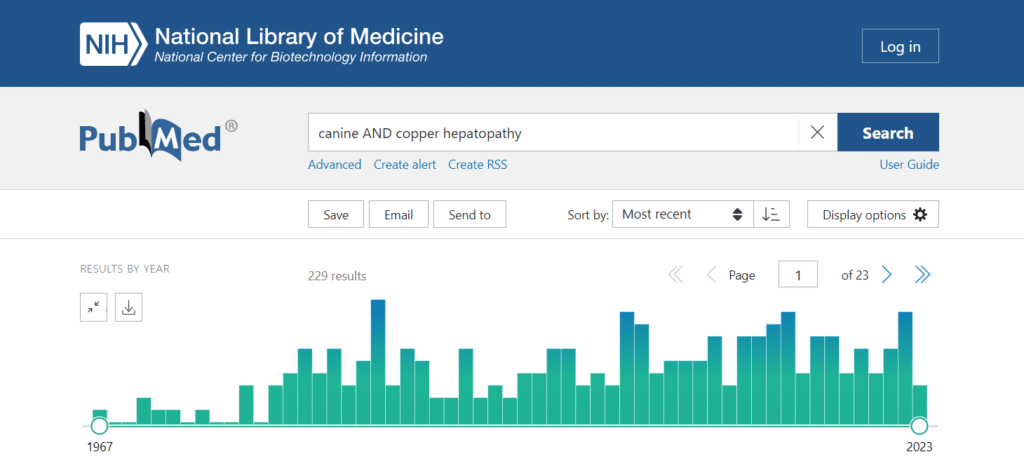Canine Liver Disease and Elevated Copper Levels: What Dog Owners Need to Know

Canine Liver Disease and Elevated Copper Levels: What Dog Owners Need to Know
There’s been a connection between canine liver disease and elevated levels of copper seen in a liver biopsy since the late 1970’s when veterinarians from the Schwarzman Animal Medical Center, in collaboration with researchers from Albert Einstein School of Medicine, identified copper storage disease in Bedlington terrriers. Twenty-eight years later, researchers identified a gene mutation in COMMD1, a gene controlling copper metabolism, as the cause of the copper storage disease in Bedlington terriers.
However, the link between copper and liver disease in dogs extends beyond this gene mutation, and veterinary researchers continue to study the connection. The image below shows a graphic representation of a National Library of Medicine database search for publications that meet the search criteria “canine AND copper hepatopathy”. (Hepatopathy is the medical term for liver disease.) Several of the publication peaks seen here can help explain the linkage between liver disease and copper.

Excess Copper is Bad for a Dog’s Liver
Accumulated copper in the liver damages liver cells through production of reactive oxygen molecules. Ultimately, excessive copper accumulation can lead to cirrhosis, a scarring of liver tissue. The damage caused by copper accumulation in the liver causes enzymes to leak out of the liver cells, which can be detected by routine blood tests. However, the diagnosis of copper hepatopathy can only be made by a liver biopsy and measuring the exact levels of copper in that sample. Measuring copper levels in the liver cannot be done with a blood test.
Increased Copper from Inherited Liver Disease
After the initial description of copper liver disease in Bedlington terriers, additional research led to a new description of another inherited liver disease, this time in West Highland white terriers. This discovery produced the peak of publications in 1986. Since then, many breeds of dogs – including Doberman pinschers, Dalmations and Labrador retrievers – have been identified as being predisposed to excessive copper accumulation in their livers. Veterinarians susepct inherited disorders are to blame, and, in the Labrador retriever, two genes have been associated with an increased risk of copper accumulation in the liver. However, these genes are not fully responsible, and diet appears to play a role in copper hepatopathy.
Increased Copper from Slow Bile Flow
The peak of publications around 2004 is the result of descriptions of Doberman pinschers with chronic hepatitis and elevated liver copper levels. Descriptions of a similar disease in Labradors and other dogs followed.
The cause of elevated copper concenterations in the livers of dogs with chronic hepatits is currently under debate. One theory is that when the liver is not functioning well, it does not excrete excess copper in the bile, resulting in retention of copper in the liver. However, the 2019 American College of Veterinary Internal Medicine Consensus Statement on Chronic Hepatitis in Dogs suggests an alternative explanation. The authors note that the increase in dogs with chronic hepatitis beginning in the late 1990’s coincided with an increase in the bioavailable copper in dog food. The recent peak of publications on copper, chronic hepatitis and dog food comes as reasearchers try and sort out the reason for increases in copper concentration in dog liver biopsies.
Treatment of Excess Copper in the Canine Liver
Veterinarians employ several tactics to decrease excessive copper in the liver once it is identified by a liver biopsy. Feeding a diet low in copper and adding zinc supplements to block intestinal copper absorption can reduce copper accumulation. Another option is to bind up the copper with chelating agents that allow the copper to be excreted from the body. Veterinarians also prescribe medication to protect liver cells, such as antioxidants and drugs to promote bile excretion of copper. For dogs diagnosed with copper hepatopathy, treatment and monitoring are a life-long necessity and require a biopsy to confirm the diagnosis.
The link between liver disease and accumulated copper levels is well established, but our knowledge continues to evolve as veterinary researchers work to elucidate the complicated physiology of canine liver disease.
For more reporting on copper in dog food, visit our friends at The Canine Review.































